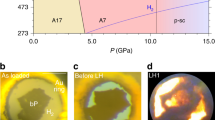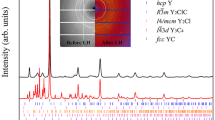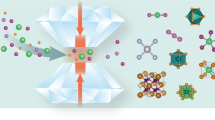Abstract
The noble gases are the most inert group of the periodic table, but their reactivity increases with pressure. Diamond-anvil-cell experiments and ab initio modelling have been used to investigate a possible direct reaction between xenon and oxygen at high pressures. We have now synthesized two oxides below 100 GPa (Xe2O5 under oxygen-rich conditions, and Xe3O2 under oxygen-poor conditions), which shows that xenon is more reactive under pressure than predicted previously. Xe2O5 was observed using X-ray diffraction methods, its structure identified through ab initio random structure searching and confirmed using X-ray absorption and Raman spectroscopies. The experiments confirm the recent prediction of Xe3O2 as a stable xenon oxide under high pressure. Xenon atoms adopt mixed oxidation states of 0 and +4 in Xe3O2 and +4 and +6 in Xe2O5. Xe3O2 and Xe2O5 form extended networks that incorporate oxygen-sharing XeO4 squares, and Xe2O5 additionally incorporates oxygen-sharing XeO5 pyramids. Other xenon oxides (XeO2, XeO3) are expected to form at higher pressures.
This is a preview of subscription content, access via your institution
Access options
Subscribe to this journal
Receive 12 print issues and online access
$259.00 per year
only $21.58 per issue
Buy this article
- Purchase on Springer Link
- Instant access to full article PDF
Prices may be subject to local taxes which are calculated during checkout






Similar content being viewed by others
References
Grochala, W. Atypical compounds of gases, which have been called ‘noble’. Chem. Soc. Rev. 36, 1632–1655 (2007).
Claassen, H. H., Selig, H. & Malm, J. G. Xenon tetrafluoride. J. Am. Chem. Soc. 84, 3593 (1962).
Chernick, C. L. et al. Fluorine compounds of xenon and radon. Science 138, 136–138 (1962).
Smith, D. F. Xenon trioxide. J. Am. Chem. Soc. 85, 816–817 (1963).
Selig, H., Claassen, H. H., Chernick, C. L., Malm, J. G. & Huston, J. L. Xenon tetroxide: preparation and some properties. Science 143, 1322–1323 (1964).
Brock, D. S. & Schrobilgen, G. J. Synthesis of the missing oxide of xenon, XeO2, and its implications for Earth's missing xenon. J. Am. Chem. Soc. 133, 6265–6269 (2011).
Sanloup, C., Mao, H.-K. & Hemley, R. J. High-pressure transformations in xenon hydrates. Proc. Natl Acad. Sci. USA 99, 25–28 (2002).
Dewaele, A., Loubeyre, P., Dumas, P. & Mezouar, M. Oxygen impurities reduce the metallization pressure of xenon. Phys. Rev. B 86, 014103 (2012).
Weck, G., Dewaele, A. & Loubeyre, P. Oxygen/noble gas binary phase diagrams at 296 K and high pressures. Phys. Rev. B 82, 014112 (2010).
Jephcoat, A. et al. Pressure-induced structural phase transitions in solid xenon. Phys. Rev. Lett. 59, 2670–2673 (1987).
Cynn, H. et al. Martensitic fcc-to-hcp transformation observed in xenon at high pressure. Phys. Rev. Lett. 86, 4552–4555 (2001).
Caldwell, W. A. et al. Geochemistry of xenon at high pressures. Science 277, 930–933 (1997).
Goettel, K. A., Eggert, J. H., Silvera, I. F. & Moss, W. C. Optical evidence for the metallization of xenon at 132(5) GPa. Phys. Rev. Lett. 62, 665–668 (1989).
Zhu, L., Liu, H., Pickard, C. J., Zou, G. & Ma, Y. Reactions of xenon with iron and nickel are predicted in the Earth's inner core. Nature Chem. 6, 644–648 (2014).
Sanloup, C., Schmidt, B. C., Perez, E. M. C., Gregoryanz, E. & Mezouar, M. Retention of xenon in quartz and Earth's missing xenon. Science 310, 1174–1177 (2005).
Sanloup, C., Bonev, S. A., Hochlaf, M. & Maynard-Casely, H. E. Reactivity of xenon with ice at planetary conditions. Phys. Rev. Lett. 110, 265501 (2013).
Glass, C. W., Oganov, A. R. & Hansen, N. USPEX—evolutionary crystal structure prediction. Comput. Phys. Comm. 175, 713–720 (2006).
Jung, D. Y. Ab Initio Studies in High Pressure Geochemistry PhD thesis, ETH Zürich (2008).
Zhu, Q. et al. Stability of xenon oxides at high pressures. Nature Chem. 5, 61–65 (2013).
Hermann, A. & Schwerdtfeger, P. Xenon suboxides stable under pressure. J. Phys. Chem. Lett. 5, 4336–4342 (2014).
Oganov, A. R. et al. Ionic high-pressure form of elemental boron. Nature 457, 863–867 (2009).
Pickard, C. J. & Needs, R. J. Structure of phase III of solid hydrogen. Nature Phys. 3, 473–476 (2007).
Shcheka, S. S. & Keppler, H. The origin of the terrestrial noble-gas signature. Nature 490, 531–534 (2012).
Pickard, C. J. & Needs, R. J. Ab initio random structure searching. J. Phys. Condens. Matter 23, 053201 (2011).
Pickard, C. J. & Needs, R. J. High pressure phases of silane. Phys. Rev. Lett. 97, 045504 (2006).
Bartlett, N., Einstein, F., Stewart, D. F. & Trotter, J. Crystal structure of [XeF5]+[PtF6]−. J. Chem. Soc. A 7, 1190–1193 (1967).
Weck, G., Desgreniers, S., Loubeyre, P. & Mezouar, M. Single crystal structural characterization of the metallic phase of oxygen. Phys. Rev. Lett. 102, 255503 (2009).
Mulliken, R. S. Electronic population analysis on LCAO–MO molecular wave functions. I. J. Chem. Phys. 23, 1833–1840 (1955).
Bader, R. F. W. Atoms in Molecules—A Quantum Theory (Oxford Univ. Press, 1990).
Hirshfeld, F. L. Bonded-atom fragments for describing molecular charge densities. Theor. Chim. Acta 44, 129–138 (1977).
Huston, J. L. & Claassen, H. H. Raman spectra and force constants for OsO4 and XeO4 . J. Chem. Phys. 52, 5646–5648 (1970).
Claassen, H. H. & Knapp, G. Raman spectrum of xenic acid. J. Chem. Soc. 86, 2341–2342 (1964).
Perdew, J. P., Burke, K. & Ernzerhof, M. Generalized gradient approximation made simple. Phys. Rev. Lett. 477, 3865–3868 (1996).
Heyd, J., Scuseria, G. E. & Ernzerhof, M. Hybrid functionals based on a screened Coulomb potential. J. Chem. Phys. 118, 8207–8215 (2003).
Stewart, R. B., Jacobsen, R. T. & Wagner, W. Thermodynamic properties of oxygen from the triple point to 300 K with pressures to 80 MPa. J. Phys. Chem. Ref. Data 20, 917–1021 (1991).
Sifner, O. & Klomfar, J. Thermodynamic properties of xenon from the triple point to 800 K with pressures up to 350 MPa. J. Phys. Chem. Ref. Data 23, 63–152 (1994).
Hammersley, A. FIT2D: An Introduction and Overview. Technical Report No. ESRF97HA02 (ESRF, 1997).
Boultif, A. & Louër, D. Indexing of powder diffraction patterns for low-symmetry lattices by the successive dichotomy method. J. Appl. Cryst. 24, 987–993 (1991).
Favre-Nicolin, V. & Cerny, R. A better FOX: using flexible modelling and maximum likelihood to improve direct-space ab initio structure determination from powder diffraction. Z. Kristallogr. 219, 847–856 (2004).
Mathon, O. et al. The time-resolved and extreme conditions XAS (TEXAS) facility at the European Synchrotron Radiation Facility: the general-purpose EXAFS bending-magnet beamline BM23. J. Synchrotron Rad. 22, 1548–1554 (2015).
Ishimatsu, N. et al. Glitch-free X-ray absorption spectrum under high pressure obtained using nano-polycrystalline diamond anvils. J. Synchrotron Rad. 19, 768–772 (2012).
Ravel, B. & Newville, M. ATHENA, ARTEMIS, HEPHAESTUS: data analysis for X-ray absorption spectroscopy using IFEFFIT. J. Synchrotron Rad. 12, 537–541 (2005).
Dewaele, A., Loubeyre, P. & Mezouar, M. Equations of state of six metals above 94 GPa. Phys. Rev. B 70, 094112 (2004).
Anzellini, S., Dewaele, A., Occelli, F., Loubeyre, P. & Mezouar, M. Equation of state of rhenium and application for ultra high pressure calibration. J. Appl. Phys. 115, 043511 (2014).
Akahama, Y. & Kawamura, H. Pressure calibration of diamond anvil Raman gauge to 410 GPa. J. Phys. Conf. Series 215, 012195 (2010).
Clark, S. J. et al. First principles methods using CASTEP. Z. Kristallogr. 220, 567–570 (2005).
Vanderbilt, D. Soft self-consistent pseudopotentials in a generalized eigenvalue formalism. Phys. Rev. B 41, 7892–7895 (1990).
Pauling, L. The principles determining the structure of complex ionic crystals. J. Am. Chem. Soc. 51, 1010–1026 (1929).
Momma, K. & Izumi, F. VESTA 3 for three-dimensional visualization of crystal, volumetric and morphology data. J. Appl. Crystallogr. 44, 1272–1276 (2011).
Kraus, W. & Nolze, G. POWDER CELL—a program for the representation and manipulation of crystal structures and calculation of the resulting X-ray powder patterns. J. Appl. Cryst. 29, 301–303 (1996).
Morris, A. J., Nicholls, R. J., Pickard, C. J. & Yates, J. R. OptaDOS: a tool for obtaining density of states, core-level and optical spectra from electronic structure codes. Comp. Phys. Comm. 185, 1477–1485 (2014).
Vinet, P., Ferrante, J., Rose, J. & Smith, J. Compressibility of solids. J. Geophys. Res. 92, 9319–9325 (1987).
Acknowledgements
The authors acknowledge the ESRF for the provision of beamtime under proposals HS-4067 and HC-767. Financial support was provided by the Engineering and Physical Sciences Research Council of the UK (EP/J017639/1). Computational resources were provided by the High Performance Computing Service at the University of Cambridge and the Archer facility of the UK's National High-Performance Computing Service, for which access was obtained via the UK Car–Parrinello Consortium (EP/K014560/1). C.J.P. is supported by the Royal Society through a Royal Society Wolfson Research Merit Award. Nanopolycrystalline diamond anvils were prepared based on Japan Society for the Promotion of Science grants (No. 25220712 and No. 15H05829) to T.I. We thank M. Hanfland for the use of his laser heating set-up, and P. Loubeyre, S. Mazevet, C. Sanloup and J. Trail for helpful discussions.
Author information
Authors and Affiliations
Contributions
A.D. proposed the research, and A.D. and R.J.N. coordinated the research. A.D. performed the experiments at the synchrotron source with the help of O.M. and M.M. T.I. provided the nanopolycrystalline diamond anvils. A.D. and S.P. analysed experimental data. N.W. and C.J.P. performed the theoretical and computational work. R.J.N., A.D. and N.W. wrote the paper. All the authors commented on the manuscript.
Corresponding author
Ethics declarations
Competing interests
The authors declare no competing financial interests.
Supplementary information
Supplementary information
Supplementary information (PDF 1629 kb)
Supplementary information
Theoretically derived crystallographic data for the Xe2O5 structure at 83GPa. (CIF 10 kb)
Supplementary information
Theoretically derived crystallographic data for the Xe2O structure at 83GPa. (CIF 16 kb)
Supplementary information
Theoretically derived crystallographic data for the Xe3O2 structure at 83GPa. (CIF 5 kb)
Supplementary information
Theoretically derived crystallographic data for the XeO2 structure at 200GPa. (CIF 9 kb)
Supplementary information
Theoretically derived crystallographic data for the XeO3 structure at 150GPa. (CIF 9 kb)
Rights and permissions
About this article
Cite this article
Dewaele, A., Worth, N., Pickard, C. et al. Synthesis and stability of xenon oxides Xe2O5 and Xe3O2 under pressure. Nature Chem 8, 784–790 (2016). https://doi.org/10.1038/nchem.2528
Received:
Accepted:
Published:
Issue Date:
DOI: https://doi.org/10.1038/nchem.2528
This article is cited by
-
Structural Changes in Polycrystalline Indium Oxide After Irradiation with Xenon Ions
Refractories and Industrial Ceramics (2023)
-
Open questions on the high-pressure chemistry of the noble gases
Communications Chemistry (2022)
-
Hadean isotopic fractionation of xenon retained in deep silicates
Nature (2022)
-
Materials under high pressure: a chemical perspective
Applied Physics A (2022)
-
Xenon iron oxides predicted as potential Xe hosts in Earth’s lower mantle
Nature Communications (2020)



